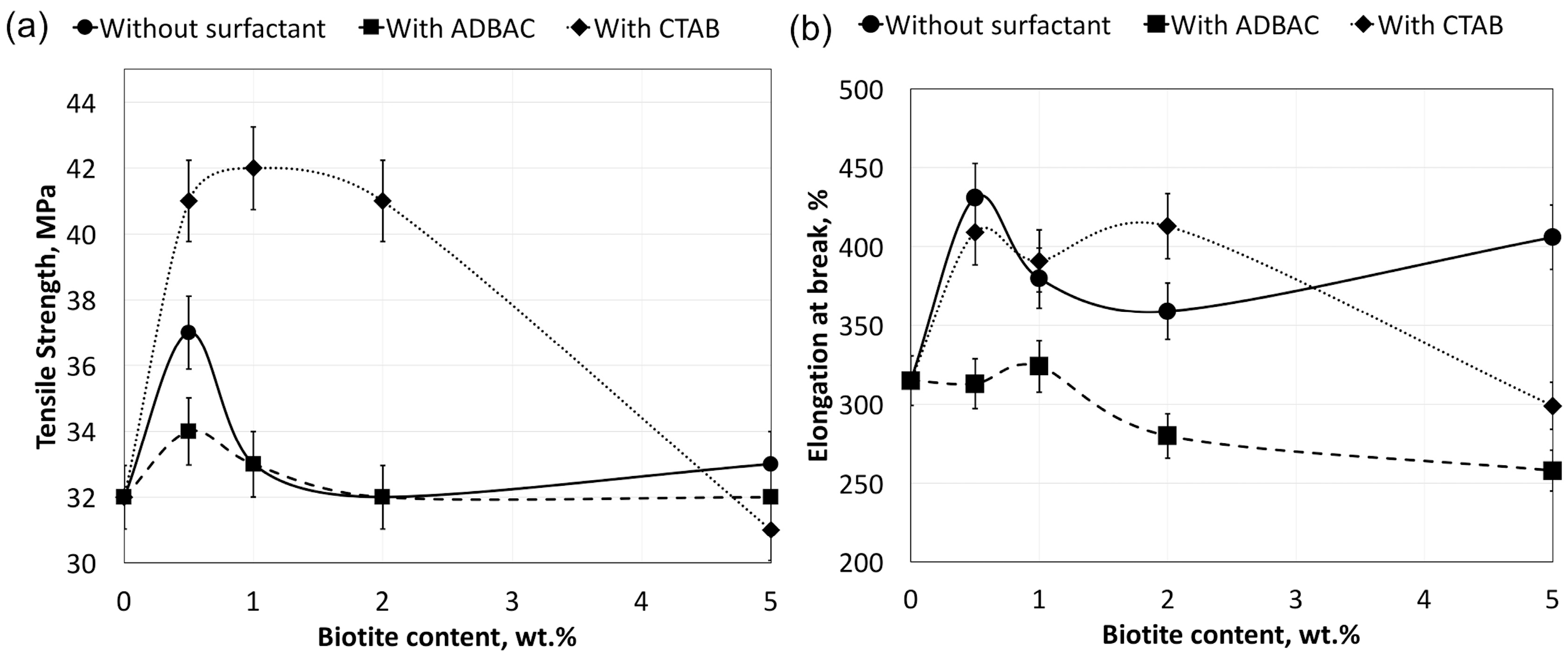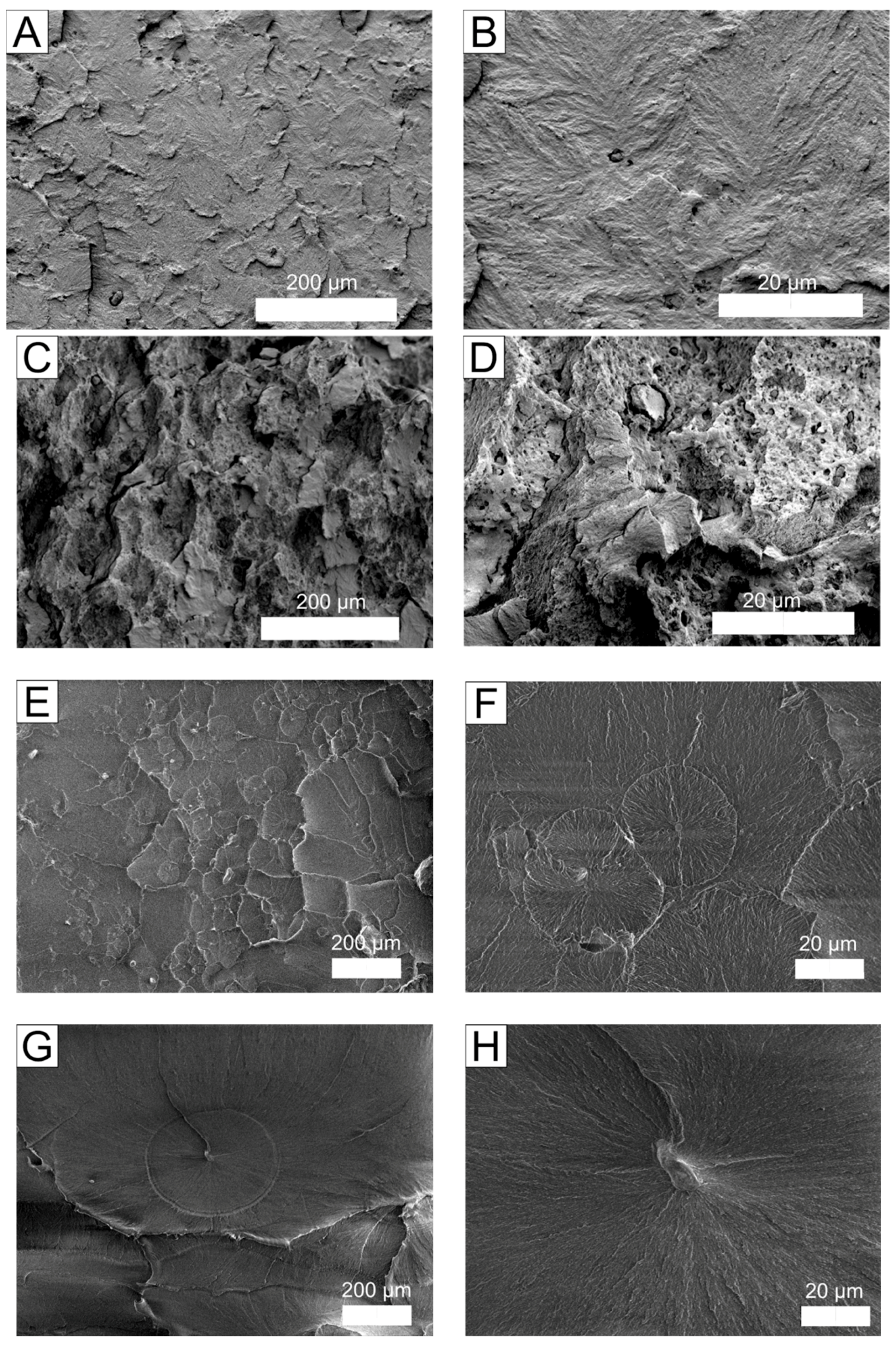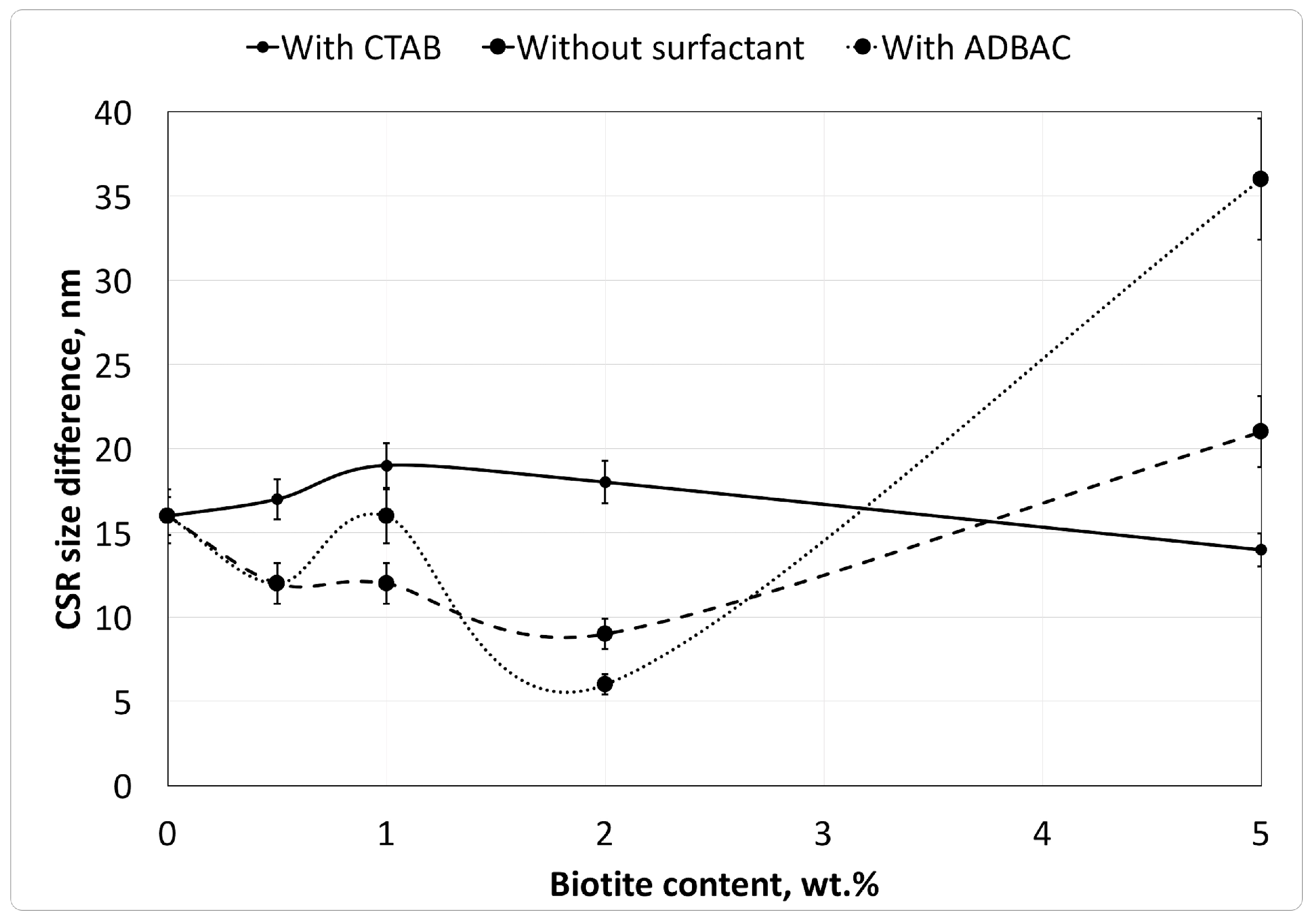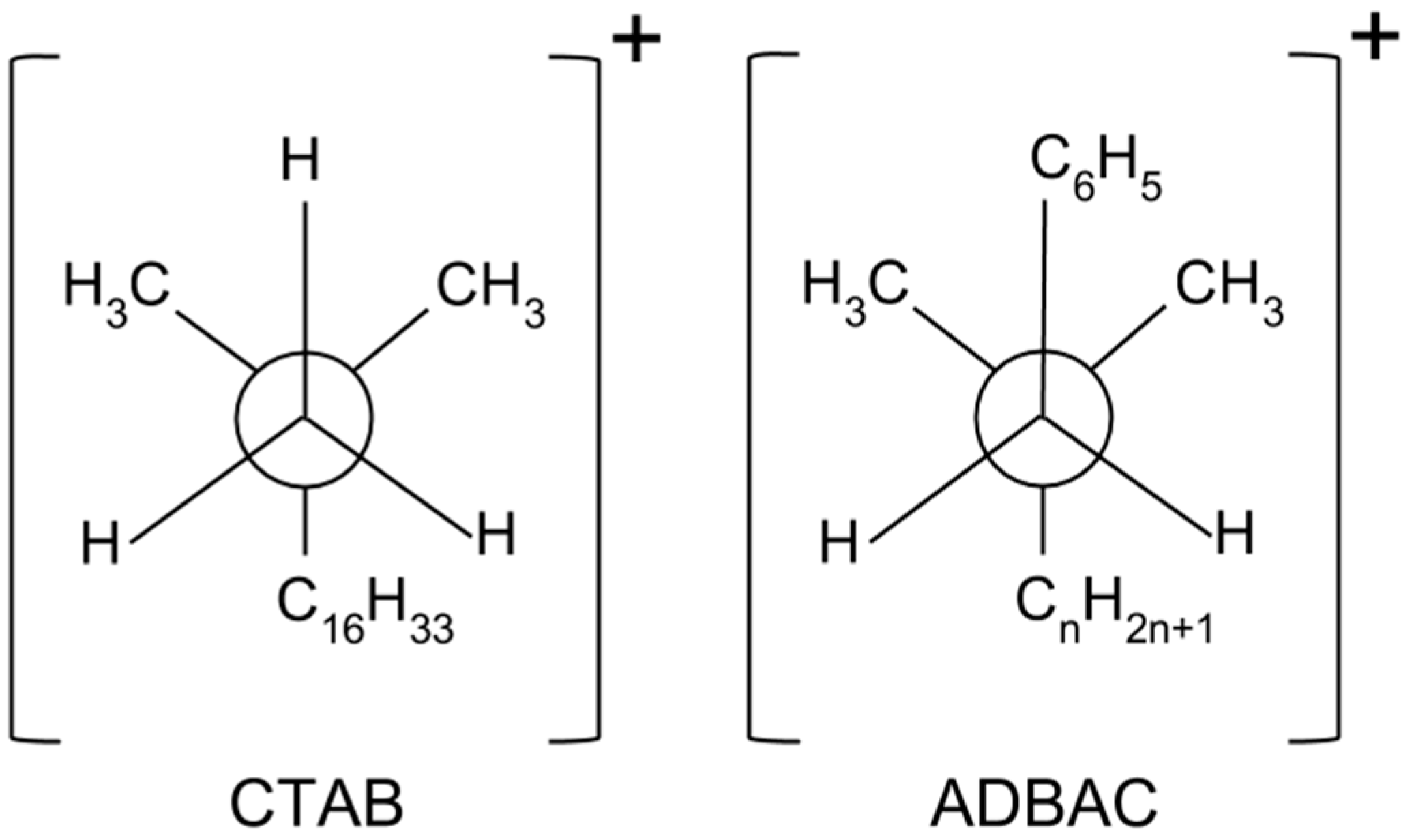Surfactant Effects on Structure and Mechanical Properties of Ultrahigh-Molecular-Weight Polyethylene/Layered Silicate Composites
Abstract
:1. Introduction
2. Experimental Section
3. Result and Discussion
4. Conclusions
Acknowledgment
Author Contributions
Conflicts of Interest
References
- Sciancalepore, C.; Bondioli, F.; Messori, M.; Barrera, G.; Tiberto, P.; Allia, P. Epoxy nanocomposites functionalized with in situ generated magnetite nanocrystals: Microstructure, magnetic properties, interaction among magnetic particles. Polymer 2015, 59, 278–289. [Google Scholar] [CrossRef]
- Koivurova, T. Race to Resources in the Arctic: Have We Progressed in Our Understanding of What Takes Place in the Arctic? The New Arctic; Springer: Berlin, Germany, 2015; pp. 189–201. [Google Scholar]
- Kurtz, S.M. The UHMWPE Handbook: Ultrahigh-Molecular-Weight Polyethylene in Total Joint Replacement; Academic Press: San Diego, CA, USA, 2004. [Google Scholar]
- Aldousiri, B.; Shalwan, A.; Chin, C.W. A Review on Tribological Behaviour of Polymeric Composites and Future Reinforcements. Adv. Mater. Sci. Eng. 2013, 2013, 645923. [Google Scholar]
- Pang, H.; Chen, C.; Bao, Y.; Chen, J.; Ji, X.; Lei, J.; Li, Z.M. Electrically conductive carbon nanotube/ultrahigh molecular weight polyethylene composites with segregated and double percolated structure. Mater. Lett. 2012, 79, 96–99. [Google Scholar] [CrossRef]
- Chen, Y.; Qi, Y.; Tai, Z.; Yan, X.; Zhu, F.; Xue, Q. Preparation, mechanical properties and biocompatibility of graphene oxide/ultrahigh molecular weight polyethylene composites. Eur. Polym. J. 2012, 48, 1026–1033. [Google Scholar] [CrossRef]
- Kirillina, I.V.; Nikiforov, L.A.; Okhlopkova, A.A.; Sleptsova, S.A.; Yoon, C.; Cho, J.H. Nanocomposites based on polytetrafluoroethylene and ultrahigh molecular weight polyethylene: A brief review. Bull. Korean Chem. Soc. 2014, 35, 3411–3420. [Google Scholar] [CrossRef]
- Shokuhfar, A.; Zare-Shahabadi, A.; Atai, A.A.; Ebrahimi-Nejad, S.; Termeh, M. Predictive modeling of creep in polymer/layered silicate nanocomposites. Polym. Test. 2012, 31, 345–354. [Google Scholar] [CrossRef]
- Alexandre, M.; Dubois, P. Polymer-layered silicate nanocomposites: preparation, properties and uses of a new class of materials. Mater. Sci. Eng. 2000, 28, 1–63. [Google Scholar] [CrossRef]
- Ke, Y.C.; Stroeve, P. Polymer-Layered Silicate and Silica Nanocomposites; Elsevier: Amsterdam, The Netherlands, 2005. [Google Scholar]
- Ray, S.S.; Okamoto, M. Polymer/layered silicate nanocomposites: A review from preparation to processing. Prog. Polym. Sci. 2003, 28, 1539–1641. [Google Scholar]
- Giannelis, E.P. Polymer/layered silicate nanocomposites: A review from preparation to processing. Appl. Organomet. Chem. 1998, 12, 675–680. [Google Scholar] [CrossRef]
- Wu, G.M.; Schartel, B.; Bahr, H.; Kleemeier, M.; Yu, D.; Hartwig, A. Experimental and quantitative assessment of flame retardancy by the shielding effect in layered silicate epoxy nanocomposites. Combust. Flame 2012, 159, 3616–3623. [Google Scholar] [CrossRef]
- Khare, H.S.; Burris, D.L. A quantitative method for measuring nanocomposite dispersion. Polymer 2010, 51, 719–729. [Google Scholar] [CrossRef]
- Kango, S.; Kalia, S.; Celli, A.; Njuguna, J.; Habibi, Y.; Kumar, R. Surface modification of inorganic nanoparticles for development of organic–inorganic nanocomposites—A review. Prog. Polym. Sci. 2013, 38, 1232–1261. [Google Scholar] [CrossRef]
- Gong, X.; Liu, J.; Baskaran, S.; Voise, R.D.; Young, J.S. Surfactant-assisted processing of carbon nanotube/polymer composites. Chem. Mater. 2000, 12, 1049–1052. [Google Scholar] [CrossRef]
- Pavlidoua, S.; Papaspyrides, C.D. A review on polymer–layered silicate nanocomposites. Prog. Polym. Sci. 2008, 33, 1119–1198. [Google Scholar] [CrossRef]
- Lee, S.R.; Park, H.M.; Lim, H.L.; Kang, T.; Li, X.; Cho, W.J.; Ha, C.S. Microstructure, tensile properties, and biodegradability of aliphatic polyester/clay nanocomposites. Polymer 2002, 43, 2495–2500. [Google Scholar] [CrossRef]
- Mittal, V. Polymer Layered Silicate Nanocomposites: A Review. Materials 2009, 2, 992–1057. [Google Scholar] [CrossRef]
- Chen, R.S.; Ahmad, S. Mechanical performance and flame retardancy of rice husk/organoclay-reinforced blend of recycled plastics. Mater. Chem. Phys. 2017, 198, 57–65. [Google Scholar] [CrossRef]
- Fermino, D.M.; Oliani, W.L.; Andrade, C.G.B.; Lugão, A.B.; Parra, D.F.; Valenzuela Diaz, F.R. Characterization of Minerals, Metals, and Materials 2015; Springer: San Paulo, Brazil, 2016; pp. 659–666. [Google Scholar]
- Ticona, G.U.R. “Ultrahigh-Molecular-Weight Polyethylene (PE-UHMW)” Brochure; Ticona GmbH: Sulzbach, Germany, 2001; pp. 14–16 and p. 36. [Google Scholar]
- GUR UHMW-PE. Available online: http://www.celanese.com/engineered-materials/products/GUR-UHMW-PE.aspx (accessed on 20 July 2015).
- Beyer, M.K.; Clausen-Schaumann, H. Mechanochemistry: The mechanical activation of covalent bonds. Chem. Rev. 2005, 105, 2921–2948. [Google Scholar] [CrossRef] [PubMed]
- Boldyrev, V.V.; Tkáčová, K. Mechanochemistry of solids: Past, present, and prospects. J. Mater. Synth. Process. 2000, 8, 121–132. [Google Scholar] [CrossRef]
- Ning, N.; Fu, S.; Zhang, W.; Chen, F.; Wang, K.; Deng, H.; Zhang, Q.; Fu, Q. Realizing the enhancement of interfacial interaction in semicrystalline polymer/filler composites via interfacial crystallization. Prog. Polym. Sci. 2012, 37, 1425–1455. [Google Scholar] [CrossRef]
- Zak, A.K.; Majid, W.A.; Abrishami, M.E.; Yousefi, R. X-ray analysis of ZnO nanoparticles by Williamson–Hall and size–strain plot methods. Solid State Sci. 2011, 13, 251–256. [Google Scholar]
Sample Availability: Samples of the composites are not available from the authors. |





| Sample | α, % | CSR Size (Williamson-Hall), nm | CSR Size (Scherrer), nm |
|---|---|---|---|
| Initial UHMWPE | 54 | 30 | 14 |
| UHMWPE + 0.5 wt % biotite | 55 | 26 | 14 |
| UHMWPE + 1 wt % biotite | 53 | 27 | 15 |
| UHMWPE + 2 wt % biotite | 55 | 20 | 11 |
| UHMWPE + 5 wt % biotite | 50 | 37 | 16 |
| UHMWPE + 0.5 wt % biotite + CTAB | 53 | 32 | 15 |
| UHMWPE + 1 wt % biotite + CTAB | 52 | 33 | 14 |
| UHMWPE + 2 wt % biotite + CTAB | 54 | 34 | 16 |
| UHMWPE + 5 wt % biotite + CTAB | 53 | 31 | 17 |
| UHMWPE + 0.5 wt % biotite + ADBAC | 60 | 28 | 16 |
| UHMWPE + 1 wt % biotite + ADBAC | 60 | 31 | 15 |
| UHMWPE + 2 wt % biotite + ADBAC | 60 | 23 | 17 |
| UHMWPE + 5 wt % biotite + ADBAC | 62 | 52 | 16 |
© 2017 by the authors. Licensee MDPI, Basel, Switzerland. This article is an open access article distributed under the terms and conditions of the Creative Commons Attribution (CC BY) license (http://creativecommons.org/licenses/by/4.0/).
Share and Cite
Nikiforov, L.A.; Okhlopkova, T.A.; Kapitonova, I.V.; Sleptsova, S.A.; Okhlopkova, A.A.; Shim, E.L.; Cho, J.-H. Surfactant Effects on Structure and Mechanical Properties of Ultrahigh-Molecular-Weight Polyethylene/Layered Silicate Composites. Molecules 2017, 22, 2149. https://doi.org/10.3390/molecules22122149
Nikiforov LA, Okhlopkova TA, Kapitonova IV, Sleptsova SA, Okhlopkova AA, Shim EL, Cho J-H. Surfactant Effects on Structure and Mechanical Properties of Ultrahigh-Molecular-Weight Polyethylene/Layered Silicate Composites. Molecules. 2017; 22(12):2149. https://doi.org/10.3390/molecules22122149
Chicago/Turabian StyleNikiforov, Leonid A., Tatinana A. Okhlopkova, Iullia V. Kapitonova, Sardana A. Sleptsova, Aitalina A. Okhlopkova, Ee Le Shim, and Jin-Ho Cho. 2017. "Surfactant Effects on Structure and Mechanical Properties of Ultrahigh-Molecular-Weight Polyethylene/Layered Silicate Composites" Molecules 22, no. 12: 2149. https://doi.org/10.3390/molecules22122149
APA StyleNikiforov, L. A., Okhlopkova, T. A., Kapitonova, I. V., Sleptsova, S. A., Okhlopkova, A. A., Shim, E. L., & Cho, J.-H. (2017). Surfactant Effects on Structure and Mechanical Properties of Ultrahigh-Molecular-Weight Polyethylene/Layered Silicate Composites. Molecules, 22(12), 2149. https://doi.org/10.3390/molecules22122149






